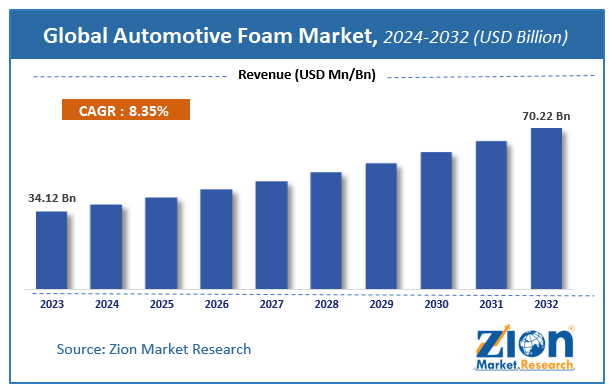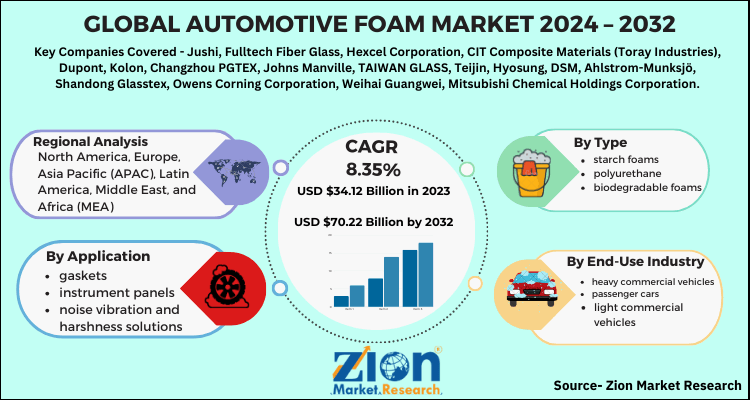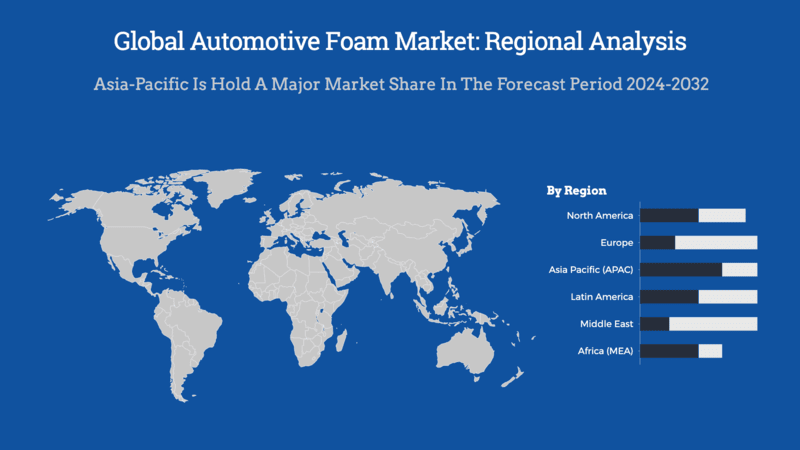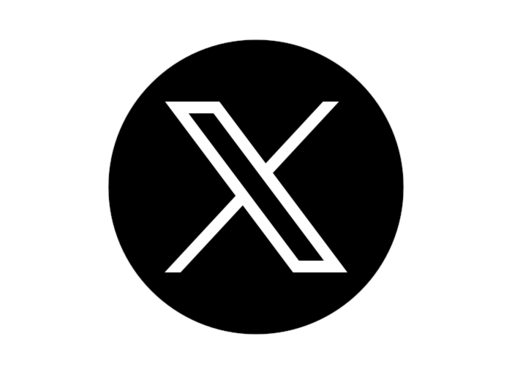Automotive Foam Market Size, Share, Trends Report, 2032

Automotive Foam Market: By Type (Polyurethane (PU) Foam, Polyolefin (PO) Foam, and Others), By Application (Interior and Exterior), By End-User (Passenger Cars, Light Commercial Vehicles (LCV) and Heavy Commercial Vehicles (HCV)), and By Region: Global Industry Perspective, Comprehensive Analysis and Forecast, 2024 - 2032
| Market Size in 2023 | Market Forecast in 2032 | CAGR (in %) | Base Year |
|---|---|---|---|
| USD 34.12 Billion | USD 70.22 Billion | 8.35% | 2023 |
Automotive Foam Market Insights
According to Zion Market Research, the global Automotive Foam Market was worth USD 34.12 Billion in 2023. The market is forecast to reach USD 70.22 Billion by 2032, growing at a compound annual growth rate (CAGR) of 8.35% during the forecast period 2024-2032. The report offers a comprehensive analysis of the market, highlighting the factors that will determine growth, potential challenges, and opportunities that could emerge in the Automotive Foam industry over the next decade.
Global Automotive Foam Market: Overview
Automotive foams are normally polymer foams formed by combining two phases such as solid and gas quickly to form the foam. These two phases are rapidly combined for the system to respond smoothly. The foam integrated with air bubbles is known as closed cell structure or open cell structure. Open-cell foams are generally flexible, whereas closed-cell foams are rigid. For the production of automotive foam, the gas involved is either chemical or physical and is termed a blowing agent.
In the foaming process, physical blowing agents are not directly involved in the chemical reaction; hence, they are static. However, chemical blowing agents are taking part in the chemical reaction; they decompose and release chemicals in the foaming process.
Automotive Foam Market: Growth Factors
Some main factors driving the global automotive foam market are cost-effectiveness, low density, and weight reduction. The automotive foam also offers low heat transfer and optimal insulator properties; these are key factors fuelling the demand of global automotive foams over other alternatives. Additionally, automotive foams provide extra comfort, softness, and flexibility to passengers; this is anticipated to propel the growth of the global market.
Moreover, increasing consumer inclination towards polymer foams in vehicles and manufacturers focusing on automotive foam in the commercial vehicle application is expected to fuel the overall growth of the global automotive foam market.
Key Insights
- As per the analysis shared by our research analyst, the global Automotive Foam Market is estimated to grow annually at a CAGR of around 8.35% over the forecast period (2024-2032).
- In terms of revenue, the global Automotive Foam Market size was valued at around USD 34.12 Billion in 2023 and is projected to reach USD 70.22 Billion by 2032.
- Based on the Type, the Polyurethane (PU) Foam PU foam leads the market due to its excellent mechanical strength, flexibility, and cost-effectiveness. It's widely used in various automotive components, including seats, armrests, headrests, door panels, and bumpers, contributing to vehicle weight reduction and enhanced fuel efficiency.
- Based on the Application, The seating application dominates, accounting for a significant share of the market. The use of foam in seats enhances comfort and support, reducing vibrations that can lead to discomfort or injury during extended periods of driving.
- Based on the End-User, This segment holds the largest market share, driven by the increasing demand for personal vehicles and the emphasis on comfort and safety features that utilize foam materials extensively.
- Based on the Region, the Asia-Pacific (APAC) APAC is the largest and fastest-growing region in the automotive foam market. Factors such as rising disposable incomes, increasing vehicle production, and growing demand for personal mobility contribute to this dominance. Countries like China and India are central to this growth, with China being the world's largest automobile market by production and sales.
Global Automotive Foam Market: Dynamics
Key Growth Drivers
The automotive foam market is primarily driven by the increasing demand for lightweight materials in the automotive industry to enhance fuel efficiency and reduce emissions. Automotive foams, known for their lightweight and high-performance properties, are widely used in vehicle interiors, seating, and insulation applications. Additionally, the growing consumer preference for comfortable and luxurious vehicle interiors further accelerates the demand for high-quality foams. Stringent government regulations on fuel efficiency and carbon emissions are encouraging automakers to adopt innovative materials, further propelling the market growth. The rise in electric vehicle (EV) production also contributes to the expanding use of automotive foams for battery insulation and noise reduction.
Restraints
Despite its growth potential, the automotive foam market faces several restraints. The fluctuating prices of raw materials, particularly polyurethane and polyolefin, pose a significant challenge for manufacturers. Additionally, the environmental concerns associated with the production and disposal of synthetic foams, which are non-biodegradable and can contribute to pollution, act as a restraint. Regulatory pressures on the use of volatile organic compounds (VOCs) in foam manufacturing further limit market expansion. Moreover, the availability of alternative materials, such as natural fibers and biodegradable composites, may reduce the reliance on traditional automotive foams.
Opportunities
The increasing emphasis on electric and autonomous vehicles offers lucrative opportunities for the automotive foam market. With the rising adoption of EVs, the need for lightweight materials to extend battery range is driving the demand for advanced foams. Furthermore, the growing trend of sustainable manufacturing practices has led to innovations in eco-friendly and recyclable foams, providing a competitive edge for companies investing in green technologies. Emerging markets in Asia-Pacific, particularly China and India, are witnessing rapid automobile production and infrastructure development, creating further opportunities for foam manufacturers. Collaborations and partnerships between automotive companies and material suppliers to develop customized foam solutions also open new growth avenues.
Challenges
The automotive foam market faces challenges related to the recyclability and disposal of foam materials. While sustainability is becoming a key focus, most traditional foams remain difficult to recycle, leading to increased waste generation. Additionally, intense competition among foam manufacturers results in pricing pressures and reduced profit margins. The ongoing supply chain disruptions and geopolitical tensions may also impact the availability of raw materials and hinder production. Furthermore, maintaining consistent product quality and adhering to varying regulatory standards across regions pose challenges for global market players. Companies must continuously innovate and invest in research and development to address these issues and remain competitive in the market.
Automotive Foam Market: Report Scope
| Report Attributes | Report Details |
|---|---|
| Report Name | Automotive Foam Market |
| Market Size in 2023 | USD 34.12 Billion |
| Market Forecast in 2032 | USD 70.22 Billion |
| Growth Rate | CAGR of 8.35% |
| Number of Pages | 210 |
| Key Companies Covered | BASF Chemical Company, Woodbridge Foam Corporation, Recticel, Johnson Controls, Bridgestone Corporation, Vitafoams, Lear Corporation, The Dow Chemical Company, Armacell, and Saint-Gobain |
| Segments Covered | By Type, By Application, By End-User, and By Region |
| Regions Covered | North America, Europe, Asia Pacific (APAC), Latin America, Middle East, and Africa (MEA) |
| Base Year | 2023 |
| Historical Year | 2018 to 2022 |
| Forecast Year | 2024 - 2032 |
| Customization Scope | Avail customized purchase options to meet your exact research needs. Request For Customization |
Automotive Foam Market: Segmentation Analysis
The Automotive Foam Market can be segmented by type, application, end-user, and region. All the segments have been analyzed based on present and future trends and the market is estimated from 2024 to 2032.
The Automotive Foam Market can be segmented by type into Polyurethane (PU) Foam and Polyolefin (PO) Foam, each serving specific functions within the automotive industry due to their distinct properties and applications. Polyurethane (PU) Foam dominates the market due to its wide-ranging applications in comfort, insulation, and interior components. However, Polyolefin (PO) Foam is rapidly gaining popularity due to its lightweight properties and increasing focus on sustainability in the automotive sector.
The Automotive Foam Market can also be segmented by application into Interior and Exterior, reflecting the specific uses of foam materials in enhancing vehicle functionality, comfort, and efficiency. The Interior segment dominates the market due to the extensive use of foam in seating, insulation, and noise reduction, which are critical for passenger comfort and experience. However, the Exterior segment is growing steadily, driven by safety regulations and lightweighting initiatives.
The Automotive Foam Market can also be segmented by end-user into Passenger Cars, Light Commercial Vehicles (LCV), and Heavy Commercial Vehicles (HCV). The Passenger Cars segment dominates in terms of volume and value due to high production rates and extensive use of foam in interiors and NVH applications. However, the Light Commercial Vehicles (LCV) segment is growing rapidly, driven by logistics and fleet electrification, while Heavy Commercial Vehicles (HCV) demand durable foam solutions for industrial transport.
The regional segment includes the current and forecast demand for North America, Europe, Asia Pacific, Latin America, and the Middle East and Africa.
Automotive Foam Market: Regional Analysis
The global automotive foam market is experiencing significant growth, with projections indicating an increase from USD 32.37 billion in 2023 to USD 64.16 billion by 2032, reflecting a compound annual growth rate (CAGR) of 7.9%. This growth is driven by the increasing use of foam materials to enhance vehicle safety, comfort, and fuel efficiency.
North America
In North America, the United States leads the automotive foam market, supported by advanced manufacturing techniques and stringent regulatory standards that demand high-performance materials for safety and fuel efficiency. Canada and Mexico also contribute to market growth, with Canada focusing on strong industrial segments and Mexico leveraging its strategic location and ambitious reforms to expand its global market share.
Europe
Europe's market is characterized by a strong emphasis on sustainability and innovation, particularly in automotive hubs such as Germany, France, and Italy. Germany's resilient industry is adapting to evolving market dynamics, while France anticipates steady consumer sentiment and economic recovery. Italy benefits from strong process engineering capabilities and a skilled workforce.
Asia-Pacific
The Asia-Pacific region is the fastest-growing market, driven by increasing vehicle production and rising disposable incomes in countries like China, India, and Japan. China serves as an attractive hub for both domestic and multinational manufacturers, India's economy is evolving towards being more consumption-driven, and Japan is implementing strategic plans for growth in a changing environment.
Latin America
Latin America, including countries like Brazil, Argentina, and Chile, demonstrates robust growth potential. Factors such as continued urbanization, rising income levels, and infrastructure development contribute to the market outlook. Brazil, in particular, benefits from a growing middle class and increased vehicle ownership, driving demand for automotive foams.
Middle East and Africa
The Middle East and Africa are emerging as significant growth areas due to economic diversification efforts, infrastructural development, and a growing population. Countries like Saudi Arabia and the UAE are witnessing increased demand for automotive foams, supported by robust demand across segments. Africa's expanding automotive industry and rising middle class further contribute to market expansion.
Automotive Foam Market: Competitive Players
Some major players dominating the global Automotive Foam market are-
- BASF Chemical Company
- Woodbridge Foam Corporation
- Recticel
- Johnson Controls,
- Bridgestone Corporation
- Vitafoams
- Lear Corporation
- The Dow Chemical Company
- Armacell
- Saint-Gobain
The global automotive foam market is segmented as follows;
By Type
- Polyurethane (PU) Foam
- Polyolefin (PO) Foam
- Others
By Application
- Interior
- Exterior
By End-User
- Passenger Cars
- Light Commercial Vehicles (LCV)
- Heavy Commercial Vehicles (HCV)
By Region
- North America
- The U.S.
- Canada
- Europe
- France
- The UK
- Spain
- Germany
- Italy
- Rest of Europe
- Asia Pacific
- China
- Japan
- India
- South Korea
- Southeast Asia
- Rest of Asia Pacific
- Latin America
- Brazil
- Mexico
- Rest of Latin America
- Middle East & Africa
- GCC
- South Africa
- Rest of Middle East & Africa
Table Of Content
Methodology
FrequentlyAsked Questions
Automobile Industry is one of the major driving factors for the growth of the market. Furthermore increasing export of automotive products in Asia Pacific region is also considered one of the major driving factors for the growth of the market.
Global Automotive Foam Market size is set to expand from $ 34.12 Billion in 2023 to $ 70.22 Billion by 2032, with an anticipated CAGR of around 8.35% from 2024 to 2032.
Due to High demand from end-users and rising population in Asia Pacific region, North America region is dominated across the globe. Recent technological innovation is considered as one of the major driving factor across the world.
Some main participants of the Automotive Foam market are BASF Chemical Company, Woodbridge Foam Corporation, Recticel, and Johnson Controls. Other players influencing the global market are Bridgestone Corporation, Vitafoams, Lear Corporation, The Dow Chemical Company, Armacell, and Saint-Gobain.
Choose License Type
HappyClients
Zion Market Research
Tel: +1 (302) 444-0166
USA/Canada Toll Free No.+1 (855) 465-4651
3rd Floor,
Mrunal Paradise, Opp Maharaja Hotel,
Pimple Gurav, Pune 411061,
Maharashtra, India
Phone No +91 7768 006 007, +91 7768 006 008
US OFFICE NO +1 (302) 444-0166
US/CAN TOLL FREE +1 (855) 465-4651
Email: sales@zionmarketresearch.com
We have secured system to process your transaction.
Our support available to help you 24 hours a day, five days a week.
Monday - Friday: 9AM - 6PM
Saturday - Sunday: Closed








